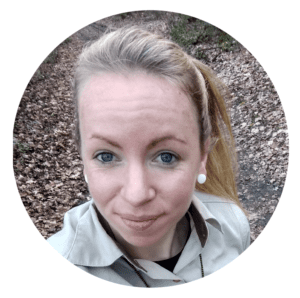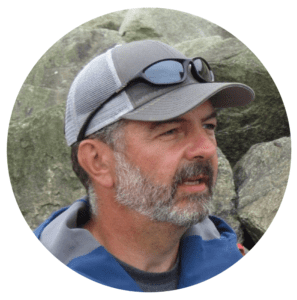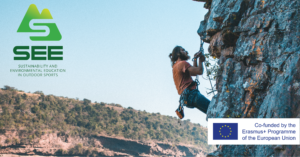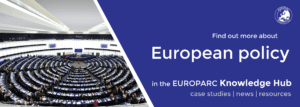Next Webinar: Why and How to Make Nature More Accessible?
Photo by Alise Lūse
Join EUROPARC’s next webinar on accessibility in Protected Areas!
- Why and How to Make Nature More Accessible?
- 7th of May, 13:00h CET
- Free – registration is needed
National Parks, nature heritage sites and symbolic landscapes are our national values and contribute to the quality of life. They are also an important source for environmental education, recreation, and tourism. But are they accessible for all?
Getting to nature can sometimes be challenging, due to a rocky path surface, a boardwalk being too narrow, too steep, too slippery or due to there being no nature trail at all. This affects not just those with a disability, but also people with temporary injuries, parents with small children, seniors, in fact, the largest part of the population. Adapting the environment and services to all is part of a sustainable development concept and is important, both from the social, as well as the economic perspective.
The aim of this webinar is to highlight why the access to nature becomes more and more present nowadays and what access options should and can be sought. Presenters from Finland, Spain and Latvia will show how being outdoors is linked to the national identity and the pressures the Covid-19 pandemic is putting on nature trails. Additionally, they will present the nature accessibility issue from the user’s point of view and share good practice examples on inclusive nature education and accessibility solutions for nature trails.
Sign up here!
Webinar Programme
By Sanna Kalmari – Accessible Travel Specialist & Travel Blogger, Finland.
Finland and other northern countries are the world’s leading destinations for nature lovers and being outdoors is inseparably connected with the national identity. That is why it’s important to make nature accessible for all, as a basic human right. Many National Parks and nature areas have accessible hiking services that meet the needs of all kinds of hikers and nature enthusiasts, including families and small children, the elderly and the physically challenged. In this presentation we hear how nature can offer meaningful experiences for a wheelchair user, what kind of information a local or a tourist with a disability needs about accessible nature trails and how to promote them.
Don’t stay at home! Accessibility in the Natural Parks Network of the Barcelona Provincial Council.
By Dafne Farré Lladó – Public Use and Environmental Education Technician, Natural Parks Network of Barcelona Provincial Council, Spain.
The Barcelona Provincial Council’s Natural Park Network consists of 12 nature areas of significant landscape, environmental and cultural value. Since 2005–2006, all its programmes, services and infrastructures are being evaluated to guarantee usability for functionally diverse people. Currently, all its school education programmes are inclusive, with adapted teaching materials and resources. At the same time, the network of accessible and practicable itineraries is constantly expanding, and natural parks offer a wide range of rental equipment (handbikes, Joëlettes, directional bars) to guarantee autonomous, safe, and comfortable access to nature for everyone.
Nature accessibility solutions and the promotion of understanding in the Central Baltic Region.
By Alise Lūse – Accessible Nature Tourism & Trails Practitioner, Latvia.
Central Baltic countries are among the top 15 countries with the largest percentage of seniors (65+ of total population of the country) in the world. Latvia, Estonia, and Finland are among the top 5 countries in Europe with the largest disability prevalence. The numbers are constantly expanding through the population growth, medical advances and the ageing process. Nowadays accessibility becomes more and more important and is the key focus of the Central Baltic Programme Project “Nature access to all”. In this presentation the project’s ambitions, main achievements and accessibility solutions will be revealed to share the best practice and encourage nature parks, municipalities and other trail administrators to make step by step improvements in their infrastructure, products and services to facilitate nature access to all.
Let’s talk about it…
All participants will have the opportunity to exchange on the topics discussed and/or ask questions.

Celebrate the Earth Day 2021: Restore our Earth!
Cetatile Ponorului portal, Apuseni Nature Park. Photo: Coras Florin
Earth Day is celebrated every year on 22 April. This year, the theme is “Restore Our Earth“. Find out how you can participate in the global celebration of our planet and read about the latest developments in the EU debate on a future restoration law.
Join the Earth Day celebrations!
On this Thursday, April 22, the theme of the yearly World Earth Day celebration is “Restore our Earth”, which focuses on natural processes, emerging green technologies, and innovative thinking that can restore the world’s ecosystems.
To celebrate this Earth Day, let’s focus on what each of us can do to address climate change. Next to large-scale mitigation and adaptation strategies, it is up to each and every one of us to take part in Restoring Our Earth – not only because we care about the natural world, but because we need it. People all around the world depend on a healthy Earth to support their jobs, livelihoods, health and happiness.
A healthy planet is not an option — it is a necessity.
Acknowledging and promoting the importance of healthy nature is one of the cornerstones of EUROPARC’s work. Therefore, we invite everyone across our network and beyond, to be part of this Earth Day and to help further climate action and nature restoration across the globe.
How can you take action?
Get inspired by just a couple of ideas on how to better connect with our planet and celebrate it on this Earth Day (and any other day):
- organise or participate in a local cleanup;
- educate yourself and the others about climate and the environment;
- engage in a citizen science initiative, for example through the Global Earth Challenge;
- use #RestoreOurEarth on social media to inspire others;
- stay informed and engaged in public debates, for example…
EU Nature Restoration Targets
It is no news that action is needed to bring back healthy nature by restoring degraded ecosystems, to improve their resilience and turn the tide against biodiversity loss. That is why in the framework of the EU’s Biodiversity Strategy for 2030, the Commission is now working on legally binding EU nature restoration targets.
To learn more about the restoration law, read the Position Paper Restoring EU’s Nature, a document agreed by environmental NGOs including the EUROPARC Federation, WWF and many others.
The new restoration law will need to achieve concrete and measurable results, since what has been done so far has not been sufficient and only with limited impact. However, the final form and real impact will be dependent on member states, who will develop national plans for implementation.
Nature restoration is a priority in the Biodiversity Strategy for 2030. Therefore, it cannot be seen in isolation from the Strategy and other environmental policies. Since the new law will concern restoration within and outside Protected Areas and Natura 2000, there is an important role to play for our members.
EUROPARC is following closely the debate with the European Commission, member states and other NGOs. We are keen to collect views and opinions of our members!
During the European Commission (EC) intervention that took place on 14 April, 3 main considerations were discussed:
- Restored areas should not degrade again. It is necessary to ensure that the investments made are long-lasting and worth. One way to do that is to designate restored areas as Protected Areas. Once designated as Protected Areas, these would contribute to the 30% targets under the Biodiversity Strategy.
- Need to acknowledge links with Natura 2000 areas. These areas require obligation to satisfy specific conservation objectives, which might include (depending on the needs on local level) restoration targets such as improving conservation or recreation of the area.
- Need to consider passive restoration (especially in the marine environment it is known as the most cost-effective way of recovering ecosystems).
Follow the debate with EUROPARC!
Although the legislative procedure is in its early stage, EUROPARC welcomes the initiative and sees its crucial role for Protected Areas and healthy nature. For the upcoming development of this debate, we especially emphasise the need to make sure restoration measures are coherent with the rest of nature conservation actions and policies.
Download the presentation of the European Commission from the meeting on 13 April to learn about the current state of play and next steps in the process.
An exchange with the EC on this topic is planned for the upcoming Seminar Dialogue in June 2021. Additionally, we have foreseen a dedicated workshop at the Conference in October.
Please contact federico.minozzi@europarc.org to share any inputs and views on this topic.
The EU Biodiversity Strategy 2030 & Protected Area targets
Western capercaillie in Sumava National Park © Marek Drha
The EU Biodiversity Strategy 2030 is ambitious and sets quite a few targets for Protected Areas. Here you can read EUROPARC’s concrete ideas and inputs on how these can be achieved.
EUROPARC’s recommendations
The EU Biodiversity Strategy for 2030 wants to
ensure that Europe’s biodiversity will be on a path to recovery by 2030 for the benefits of people, the planet, climate and our economy.
We very much welcome the high level of ambition described in the EU Biodiversity Strategy and EUROPARC is willing to actively support the European Commission and Member States to ensure an effective involvement of Protected Areas in the process and contribute to the successful implementation of the strategy.
EUROPARC represents hundreds of responsible authorities and thousands of Protected Areas in 37 countries. After discussions with our members we have summarised what is needed to make sure the Biodiversity Strategy reaches its full potential, from the perspective of Europe’s Protected Areas.
Read all our recommendations here!
The 30% target
The EU Biodiversity Strategy seeks to legally protected 30% of land within Europe. This goal shall be reached by, amongst others, designating new protected sites. EUROPARC believes this can be a very valuable and necessary tool indeed. However, when locally implemented, it can also be very controversial, as we have seen in the past. Building ownership and support for the process is therefore of great importance. Obviously, scientific criteria and evidence are essential, but if we want to achieve successful implementation and long-term benefits, the interests and rights of communities and users will also have to be considered in the process.
Additionally, EUROPARC finds it crucial, that the values of existing Protected Areas, which can effectively contribute to the targets, are identified and assessed since the beginning of the process, as this will give quick wins and would contribute to gain more support, before pushing things ahead. This means, that Protected Areas that do not have conservation as the main legal reason for their designation are also included, as they are indeed contributing towards the maintenance of biodiversity through their management actions.
Improved biodiversity management should take place in all Protected Areas, not just in those ONLY designated for conservation objectives.
This means that areas like Landscape Parks or Regional Parks should also be included, even when long-term conservation is not their only aim.
With regards to the welcome inclusion of priorities for the protection of biodiversity in urban and periurban areas. We recommend the development and adoption of specific sub-targets, measures and funds to support natural Protected Areas located in urban regions and periurban contexts, as well as the active engagement of major European cities in the process.
Management effectiveness
We do not need more paper parks. This is why EUROPARC considers management effectiveness to be a crucial point for the success of the whole process. We believe management effectiveness consists of the following core elements:
- Management planning
- Stakeholder engagement
- Capacity building
- Communication
Having in place processes and tools to monitor and assess Management Effectiveness is crucial, but this will not deliver better management per se. We need to make sure managing authorities and managers on the ground are equipped with the adequate competencies to deliver effective results. This is more than just resources. Protected Area staff need a growing range of technical skills, while managers need to provide professional leadership and direction to secure and wisely use the resources needed. A clear commitment is to be taken in this direction.
The 10% strict protection target
EUROPARC welcomes the specific target on strict protection and supports the proposed definition: “Strictly protected areas are fully and legally protected areas designated to conserve (and/or restore) the integrity of biodiversity-rich natural areas with their underlying ecological structure and supporting natural environmental processes. Natural processes are therefore left essentially undisturbed from human activity”.
However, to avoid confusion surrounding the terminology, we suggest to refer to “strict protection” and “areas being strictly protected”, as we understand there is no intent to create a new designation or management category. The focus is rather on ensuring more rigorous protection in some areas.
The dilemma between broadening or not the definition is clearly challenging. We share the view of the need to increase areas in Europe where non-intervention is the primary approach. Nevertheless, both for the success of the measures – in terms of conservation results (taking also into account climate change, invasive species and restoration requirements) – and for their applicability on the ground, we see the need to foresee, also in strictly protected areas, some specific management activities, as long as necessary for the restoration and/or conservation of the habitats and species for whom the area has been designated. Active management for biodiversity (as mowing, grazing, population control…) should only be allowed for habitats or ecosystems for which non-intervention is not the appropriate approach.
Strict protection and non-intervention does not mean inaction
EUROPARC believes that activities meant to reach conservation objectives of a site should be allowed and implemented. This includes measures to find solutions compatible with the ecological needs of the site, while recognising the needs and rights of people who have customarily used the area in question.
Funding
Funding clearly remains an important element to ensure a successful implementation of the measures. For this, adequate resources will have to be considered to support management, monitoring, capacity building and enforcement of a wider European network of Protected Areas.
For feedbacks, comments or questions, please feel free to contact Federico Minozzi
EUROPARC continues to be in active dialogue with the EU and it’s institutions. If you are interested in finding out more about our work in Brussels, check out this section of our website.
Next webinar: Outdoor Sports – Engaging with or using nature?
EUROPARC’s next webinar will take place on the 27th of April at 11:00 CET. It will look at opportunities and challenges presented to Protected Areas by increasing outdoor sports practice. You can sign up here (it’s free!).
Outdoor Sports and Nature
The connection between outdoor sports and nature seems to be an obvious one, and indeed, through the pandemic more than ever people are drawn to the outdoors. However, just because activities are practiced outside, does not necessarily mean that they are done in harmony with nature.
In some cases, outdoor sports practice can pose additional stress on already fragile habitats and sensitive species.
Protected Areas managers are therefore confronted with the task of minimising the impact of outdoor sports on local fauna and flora, and at the same time, welcoming sport practitioners and other visitors so that more people can enjoy the recognised benefits of Health Enhancing Physical Activity in the outdoors.
Sign up for the webinar here!
In this webinar, we will have the opportunity to hear from Lissa Breugelmans, an avid cyclist, with a Masters in Biology who can share a unique perspective as an outdoor enthusiast and practitioner, who understands the current impacts outdoor activities have on nature.
We will also learn from Daniele Piazza, director of the Dell’Ossola Protected Area about an integrated strategy – involving many different local stakeholders, to minimise and mitigate the effects of outdoor sports in this alpine nature park.
Myles Farnbank, from Wilderness Scotland, will present the Adventure Travel Guide Standard, a useful tool to institutions, sustainable destinations and training programs, in order to build the capacity of the Outdoor sport sector on the three core responsibilities all trainers should have: Sustainability, Safety, and Quality and Meaning.
Webinar programme
Welcome and introduction to the webinar
By Carol Ritchie, EUROPARC Federation
Dilemmas for an outdoor enthusiast
By Lissa Breugelmans, Outdoor sports practitioner and employed biologist at an ecological study bureau
The RESICETS project – Park and Outdoor Sports working together to minimise the impact of outdoor activities on wildlife
By Daniele Piazza, director of the Aree Protette dell’Ossola
The Adventure Travel Guide Standard- Showing how the Outdoor Sports sectors values nature though sustainability standards
By Myles Farnbank, Wilderness Scotland guide, fellow of The Royal Geographical Society and a Master Educator of Leave No Trace
The SEE project. Researching the issues and finding best practice
By Mike McClure, Outdoor Recreation Development Officer, Sport Northern Ireland
Let’s talk about it! All participants will have the opportunity to exchange on the topics discussed and/or to ask questions.
Final remarks and Close
By Noel Doyle, Leave No Trace Ireland
The webinar will last approximately 1h 30min and it will be hosted in English. We welcome participants from all across the network and beyond.
Get to know the case study presenters

Lissa Breugelmans
She is a trained ecologist currently working in sustainable forestry, Nature is not only her research subject and office – it’s also her favourite playground. She loves packing her bike with a few essentials and getting out there, enjoying moving through incredible landscapes and admiring biodiversity. She believes recreational outdoor users and nature protectioners share an awe for the natural world, and can be allies instead of opponents when it comes to preserving it.

Daniele Piazza
Agronomist, with more than 15 years’ experience in Natura 2000 management, planning, environmental assessment and project management both as freelance consultant and civil servant. During the last years he has been involved also in social innovation projects in marginal rural areas, with a focus on the western alpine communities. Since March 2020, he is in charge of the overall and day-to-day management of the Protected Areas of Ossola Management Body.

Myles Farnbank
Myles is an adventure guide, trainer and consultant with more than 30 years of leading clients in many of the world’s wildest places. He has been a lecturer on undergraduate programmes in Adventure Tourism and Marine & Coastal Tourism and a Masters in Ecotourism. He has had a major role in the creation of The Adventure Travel Guide Standard (ATGS) and lead the team writing the Sustainability section in the 2nd Edition published in Feb 2021.
The SEE project: Training for a more sustainable, respectful and enjoyable outdoor sport experience
This webinar will publicly launch the ERASMUS+ SEE project, in which EUROPARC is one of the partners. Led by Leave No Trace Ireland, ‘SEE’ stands for Sustainability and Environmental Education in Outdoor Sports. The project aims to tackle the un-coordinated approach to the teaching and communication of environmental ethics in the spheres of outdoor sport and recreation.

The SEE project is ultimately about ensuring that outdoor sports are managed sustainably and responsibly in nature, which should enable Protected Areas to build greater confidence and trust to allow increased participation so that more people can enjoy the benefits of outdoor sports.

